Wine Wisdom
Focus on Varietals: Gewurztraminer
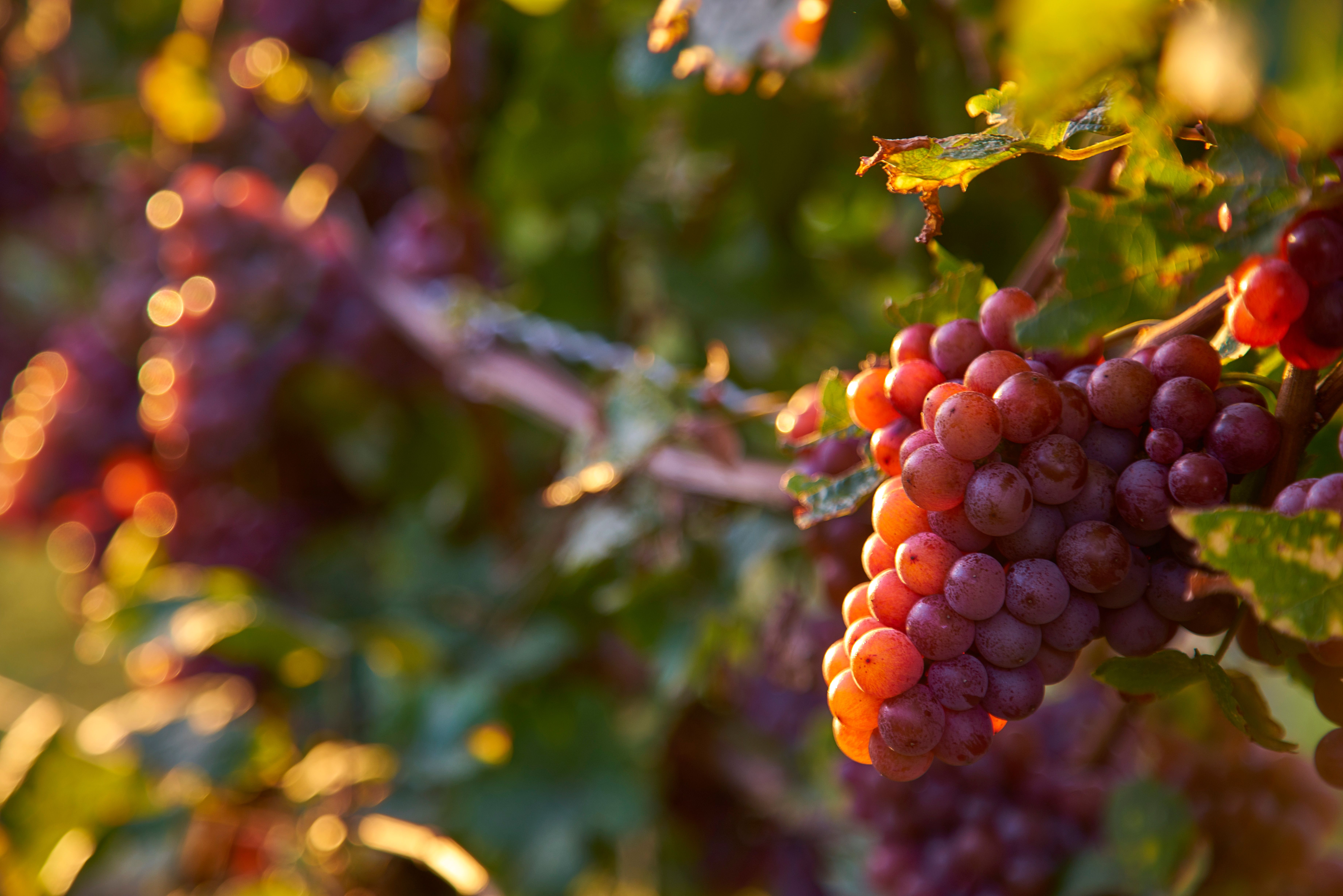
Gewurztraminer is the hard-to-say name of a unique and aromatic grape varietal that belongs to the Vitis Vinifera family. The varietal, originally called Savagnin blanc (not the widely-known Sauvignon blanc), comes from the Traminer region of northern Italy and has become known as Traminer there. Over time Gewurztraminer made its way into Germany and developed into the spicier varietal that we know today. In fact, the word Gewurz is German for spice.
During veraison, “the final stage in the grape growing process”, the fruit starts to change color on the vine and develop a beautiful bronze colour before harvest. As Gewurztraminer is a white wine, the juice is not fermented on the skins as this is what gives a wine its primary color.
Gewurztraminer is an ideal grape varietal for the cool climate grape growing region of Niagara Peninsula and produces medium to full bodied white wines with intensely fruity and floral aromas. It is somewhat of a cult varietal due to its intensity and distinct character.
Gewurztraminer can be made in a variety of wine styles from fully dry to off dry to sweet. Food pairings for Gewurztraminer are vast as it is a wine which can stand up to diverse and flavorful dishes. These wines work beautifully with Asian cuisine like spicy Thai, or aromatic dishes consisting of ginger, saffron or curry. Western style dishes are also greatly complimented by Gewurztraminer like the tradition turkey dinner, as the complexity of these wines works well with the many flavors involved.
At Strewn we have successfully worked with this captivating varietal for more than 24 years and produced a variety of styles, including from time to time, a unique barrel aged Gewurztraminer. We currently have three wines made from Gewurztraminer, two of which are dry wines, only available at the winery or through our online store.
Our top-tier 2017 Terrior Gewurztraminer ($28) displays a spicy, earthy-floral character and shows good length and viscosity on the palate. Early in 2020 we sent the wine to the top two international wine competitions in France and are delighted to share that it won Gold at both Citadelles du Vin and International Challenge du Vin.
Strewn’s second winery-exclusive Gewurztraminer is the 2018 Distinctive Small Lot Gewurztraminer Divergent ($24). This wine is made in a fruit forward and aromatic style with a fresher finish to appeal to a wider audience. It was extremely popular this past summer with our patio tastings and received a 90-point score from Natalie MacLean.
And finally Strewn has long produced a top selling, semi-dry, Two Vines Riesling-Gewurztraminer for the LCBO market ($13.95). This wine combines Riesling, which provides lovely acidity, and Gewurztraminer, which delivers aromatics and body. It recently received a score of 90 points from Carolyn Evans Hammond in the Toronto Star and may also be purchased online (free courier shipping with any 12-bottle order).
Does Stemware Really Make a Difference to Wine Enjoyment?
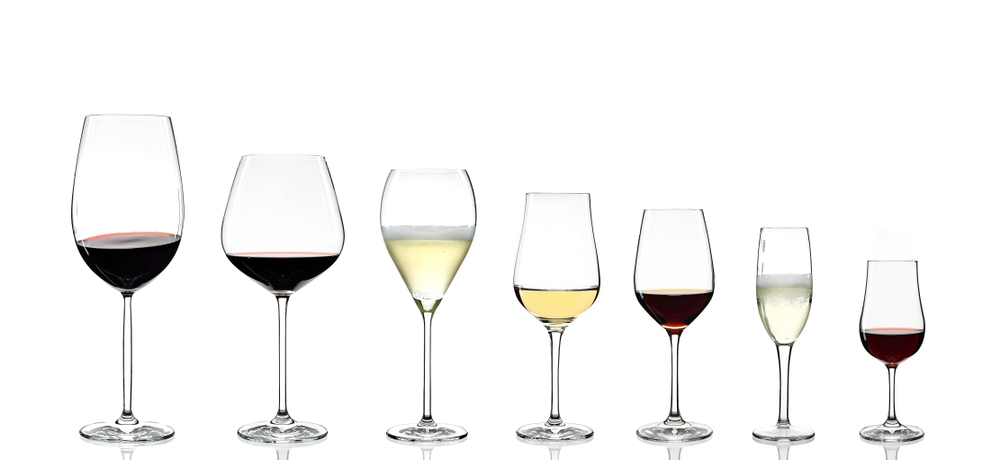
Does the size, shape and depth of a wine glass really make a difference to your enjoyment of wine? The short answer is proper stemware can often compliment or diminish aromas and flavours.
While there are many different styles of wine made from vastly different varietals, most people tend to pour it into whatever wine glasses they have at home. However, those who have enjoyed a wine tasting at either our Terroir Bar or in the Heritage Room will probably recall the many different glasses hanging in the racks. Let’s look at three main glasses we use that allow the wines to truly show their full potential.
The first is the tall, slim Aromatic White glass with a narrow bowl and tight mouth, suitable for use with Riesling and Sauvignon Blanc. Aromatic wines need very little time to breath and this shape of glass tends to emphasize ripe fruit character balanced by acidity, while the small mouth preserves floral aromas.
Regardless of the sweetness level of the wine - totally dry, semi-dry or semi-sweet – the narrow shape of the aromatic glass allows the wine to flow on to the front of your palate then down the sides to detect fruit and acidity characteristics. The small opening at the mouth allows minimal airflow to enter the glass so the wine stays cool and fresh (ideal serving temperature is between 6 and 9 Celsius).
The second glass style is Oaked Chardonnay with a very large, open bowl. This is the stemware of choice to showcase our award-winning, barrel fermented Terroir Chardonnays, which are fermented in new oak barrels then aged in them for up to a year. The resulting wine possesses both the primary aromas and flavors from the ripe fruit and the secondary aromas and flavors from the barrel.
The large open bowl allows the wine to breath, express itself and spread out across the width, which helps the wine moderate its temperature. Tip: oaked whites are often served too cool and lose their creaminess, one of the main attributes of this style of wine. Best served at 10 to 13 Celsius.
The third style of stemware is the large Bordeaux glass with a wide mouth and deep bowl. Strewn specializes in red wines using three of the traditional Bordeaux varieties: Cabernet Sauvignon, Cabernet Franc and Merlot. Our wines include premium reds (made annually to reflect vintage variation), Distinctive Small Lots (wines with a twist) and Terrior reds (made only in years with conditions that allow the production of our top-tier reds) plus some very approachable red wines for the LCBO and grocery market.
These thicker-skinned Bordeaux varietals tend to make deeper colored, more textured, fuller bodied, higher alcohol wines. Wines such as these need a glass which allows them to open up and express themselves, which is why the Bordeaux glass is just about one of the most important used at Strewn. Tip: Fill a Bordeaux glass no more than halfway. High tannin wines need room in the glass to allow proper airflow to open up the wine’s flavors and aromas as well as allowing the burn of the ethanol gas to blow off.
Bordeaux varietals are very forward and aggressive when first opened and the size of the glass will greatly aid the wine’s development. This is a glass which is a must have for any lover of truly full-bodied reds. Ideal serving temperature for Bordeaux style wines is between 16 to 19 Celsius.
At the end of the day, you can drink wine out of any glass but to effectively taste a wine it surely helps to invest into some varietal specific stemware.
Evan Clermont, WSET 3 Graduate
Hospitality Team Member
International Recognition in 2019
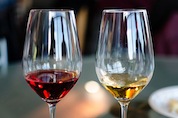
From our start more than 23 years ago, Strewn has been committed to producing premium wines from grapes grown in the Niagara peninsula. Each year gives us the opportunity to craft the very best wine we possibly can. While we know from the comments you give us that Marc Bradshaw and Tyler Bartelds are doing a great job in the cellar, it’s always good to have external validation.
In 2019, we entered two international competitions that produced outstanding results - our 2016 Terroir Chardonnay Canadian Oak won a Silver in France and the 2017 Terroir Pinot Blanc won Silver in Brussels. In both of these shows, these were the only medals awarded to Canadian wines.
Below is the complete list of competitions and awards won by Strewn this year.
VINOFED World Federation of Major International Wine and Spirits Competitions run under the patronage of OIV (Organisation Internationale de la Vigne et du Vin). VINOFED assesses wine by competent international tasters according to well-defined guidelines. Citadelles du Vin and SMV Canada are both VINOFED Competitions.
Citadelles du Vin, Bourg (near Bordeaux), France:
Silver 2016 Terroir Chardonnay Canadian Oak (only Canadian wine to win a medal)
Selections Mondiales des Vins Canada, Montreal
Gold 2016 Terroir Chardonnay Canadian Oak
Silver 2016 Terroir Chardonnay American Oak
Silver 2015 Terroir Cabernet Sauvignon
Silver 2017 The LIM ITED Amalgam
Concours Mondial de Bruxelles, Belgium Established 25 years ago, this competition has become a benchmark amongst international wine contests, known and recognised by the wine industry and consumers worldwide.
Silver 2017 Terroir Pinot Blanc (only Canadian wine to win a medal)
Then there are three prestigious competitions in the United Kingdom::
International Wine & Spirit Competition, for half a century the IWSC has been recognising and rewarding the very best wines and spirits in the world, judged by the premier experts in any given region and style.
Silver 2015 Terroir Cabernet Franc
Bronze 2017 Riesling Premium
Bronze 2017 Chimo Icewine
Decanter World Wine Awards, sponsored by Decanter magazine, is the world’s largest wine competition, held in London. In 2019 there were almost 17,000 entries and 280 judges from across the world.
Bronze 2017 Terroir Pinot Blanc
Bronze 2017 Riesling Premium
Bronze 2017 Merlot Premium
Commended 2015 Terroir Cabernet Franc
International Wine Challenge, in its 36th year, the IWC is accepted as the world’s most rigorous, impartial and influential wine competition. The IWC assesses every wine ‘blind’ and judges each for its faithfulness to style, region and vintage. Each medal-winning wine is tasted on at least three separate occasions by a minimum of 12 different judges including Masters of Wine.
Bronze 2017 Terroir Pinot Blanc
Commended 2015 Terroir Cabernet Franc
Commended 2015 LIMITED Cabernets
Commended 2017 LIMITED Amalgam
Six Nations Wine Challenge, the most influential wine judge from each of the leading New World wine countries (Australia, Canada, Chile, New Zealand, South Africa, USA) is invited to list the top 100 wines from their home country.
Judges Selection 2015 Terroir Cabernet Sauvignon
Judges Selections 2016 Terroir Merlot
National Wine Awards of Canada is a competition open tom wines grown and produced in Canada; in 2019 more than 1,815 wines from 259 wineries were entered.
Silver 2015 Terroir Cabernet Sauvignon
Silver 2017 Terroir Pinot Blanc
Bronze 2016 Terroir Chardonnay Canadian Oak
Ontario Wine Awards, founded by Tony Aspler, Order of Canada Recipient, 25 years ago as a means of recognizing Ontario VQA wines for their quality, distinction and brilliance.
Silver 2017 Terroir Pinot Blanc
Silver 2017 Chardonnay Barrel Aged
That’s more than two dozen awards for Strewn wines: 1 Gold, 10 Silver, 7 Bronze, 4 Commended and 2 Judges Selection!
Sparkling Wine Makes Any Occasion Special
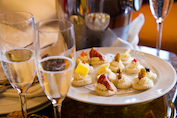
Sparkling wine means bubbles and preferably lots of them but how are the bubbles created? Yeast and sugar are added to a base wine and during a second fermentation - either in the bottle (Traditional Method) or in a pressurized Tank (Cuvee Close or Charmat style) - the yeast converts the sugar into alcohol and CO2. The carbon dioxide dissolves into the wine and voila you have bubbles.
Most Traditional Method sparkling wine, and certainly those from Champagne, are a combination of Chardonnay, Pinot Noir and Pinot Meunier. Cava, Spain’s Traditional Method sparkling wine, is made from local grape varieties although Chardonnay and Pinot Noir are permitted.
The base wine for a Traditional Method sparkling wine is typically dry, high in acidity and low in alcohol with fairly, neutral flavour. The toasty bread and biscuit notes are autolytic flavours from the yeast during the second fermentation. By comparison, more aromatic base wines are used for a Tank Fermented sparkling, the most well-known being Prosecco made from the Italian grape Glera.
Strewn’s Sparkler is made using Tank Fermentation. The base wine is an aromatic Sauvignon Blanc and we want to ensure the lovely citrus aromas and flavours of lime, lemon and grapefruit are not overwhelmed by yeasty bread and biscuit flavours, and that it has a crisp and refreshing finish on the palate.
A Versatile Food Wine
While the tradition of drinking Champagne to mark celebrations originated in the royal courts of Europe during the late 1700s, where the expensive drink was viewed as a status symbol, sparkling wine is one of the best matches for many dishes.
Sparkling wine usually contains high levels of acidity and a small amount of sugar (sweet Asti being an exception). These two extremes complement elements in almost any food, from rich, buttery salmon to red-hot Thai food. Sparkling wine penetrates to the lower layers of the rough surface of the tongue providing a super cleansing effect n the mouth.
Here are some ideas for food to enjoy with sparkling wine:
- Cheese – rich, creamy Brie or aged, hard cheeses such as Parmesan, gouda and cheddar
- Dishes that are oily, nutty (especially almonds) and egg-based (scrambled eggs anyone?).
- Any pasta or risotto dish, particularly those with cream or mushroom sauce.
- Shrimp and shellfish, smoked salmon, caviar, fried calamari, and raw oysters on the shell
- Simple tapas style dishes with a touch of saltiness, Prosciutto or Serrano ham
- Desserts that are not sweet, such as berries, shortbread cookies, pound cake, angel food cake.s dark or bittersweet chocolate.
- And don’t forget buttered-popcorn and potato chips!
What Makes a Great Vintage?
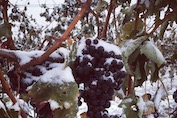
One of the questions, our Hospitality Team is frequently asked is “is this going to be a great vintage”? In Niagara, when we say it is a great vintage, we normally mean the red grape varieties are fully ripe at harvest, creating intensity of flavour and tannin. Mother Nature needs to give us lots of hot, dry, sunny weather right through October. Being a cool climate wine region, this doesn’t happen every year!
The best vintages for producing the high-quality Bordeaux red grapes that Strewn grows (Cabernet Sauvignon, Cabernet Franc and Merlot) happen on average every couple of years. We produced top-tier Terroir red wines in 2002, 2005, 2007, 2010, 2012, 2015 and 2016. We are now in the longest gap between Terroir vintages in more than 20 years.
Fortunately, the growing conditions in Niagara allow us to craft good to outstanding white wines virtually every year. Many of the white varieties benefit from slightly cooler weather, which can create refreshing acidity and crisp flavours.
What Type of Year was 2019
April and May were generally cooler and wetter than normal, which meant bud burst and blossom were about 10 days behind. Then on June 21, the first official day of summer, it turned warm and sunny, and the growing season was under way!
Warm, sunny weather continued through July and August. September, a key month for red grapes to ripen, started cool with some rain then finished with cool, sunny weather to begin the harvest season.
The cool fall weather, combined with low humidity and sunshine, provided a boost for grapes in terms of phenolic ripeness and prevented breakdown of fruit. This allowed an extended period for grapes to fully ripen, followed by an unusually early cold snap in mid-November (the earliest start for picking Icewine grapes on record!).
Most white varieties were harvested early and of excellent quality. To help reach optimal ripeness, many growers reduced the crop for the red varieties, particularly for later maturing varieties. Harvest extended into early December, sometimes taking place in the snow.
According to VQA Ontario, expect a full range of exceptional white wines defined by crispness, acid and fruit. Early reports suggest some red grapes benefited from the concentrating effect of freeze-thaw that comes with being harvested late in the season – Strewn harvested our red grapes at the Home Farm the third week of November.
A Sommelier’s perspective.
In my mind, a good year is when Mother Nature puts everything together that allows winemakers to make different styles of wines from light, crisp and refreshing white wines, creamy Chardonnays, light and medium bodied red wines to full-bodied red wines.
Every wine region in the world has “optimal growing conditions” for its wine style, the varietals grown there, geographic location and weather. For example:
The Champagne region of France produces the best sparkling wine in the world. Due to Champagne’s northern location, the growing season is short, producing under-ripe grapes with high acidity and low sugar, perfect for making sparkling wines
Napa Valley, on the other hand, is known for powerful Cabernet Sauvignons because its location and hot, dry weather conditions are perfect for growing very ripe grapes
The Niagara Peninsula region is about wine more than style or one specific grape variety. We grow many varietals, and make wine using many wine styles. Then there can be very unpredictable weather patterns s- some years are cool and wet while others are hot and dry with a long growing season.
Regardless of location, varietal or wine style, winemakers always want perfect grapes to make their best wines.
Juan Nunez-Sanchez, Strewn Estate Sommelier
Matching Wines and Sauces
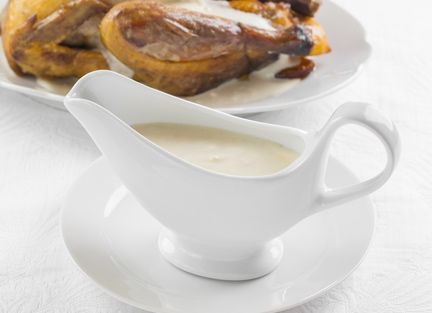
The function of a sauce is to complement the main ingredient, bring the whole dish together and add incredible flavor. While many sauces are derived from the five “mother sauces” of French cuisine (béchamel, velouté, tomate, espagnole and hollandaise), simple pan sauces that cut time but not flavour are more and more common.
How do you choose a wine to create a harmonious pairing with dishes that include sauce as an ingredient or served on the side? First, understand the sauce’s flavour and texture profile then think about styles of wine will interact.
1. Sauce Profile: Rich & Creamy
These Include: French white sauces such as béchamel, Mornay (béchamel with cheese), Hollandaise and Bernaise (emulsions of egg yolks and butter), Italian Alfredo sauce (butter, cream and cheese), and Asian sauces with coconut milk, which tend to be spicy as well as creamy.
Guiding Principles:
- To help offset the richness of the sauce choose a sparkling wine (the bubbles cut through the fat from the butter or cream) or a crisp, refreshing white wine
- For a flavour and textural match, choose a lush Chardonnay that has spent time in an oak barrel or even a lighter red
- To balance both the richness and spiciness of coconut milk curries , choose a semi-dry Riesling with good acidity and slight sweetness
2. Sauce Profile: Rich & Hearty
These Include: Espagnol (Spanish) sauce, a rich meat stock thickened with a nutty brown roux and tomato, classic French demi-glace, Bordelaise sauce (dry red wine, bone marrow, butter and shallots), and meat-based Bolognese sauce.
Guiding Principle:
- Balance the richness of the sauce by choosing a big, bold red with higher tannins, such as Cabernet Sauvignon
3. Sauce Profile: Bright & Lively
These Include: Tomato-based sauces, such as Marinara, and citrus sauces. Uncooked tomato sauces will have fresh, livelier flavour than ones made with cooked tomatoes or tomato paste (note: if you add cream, cheese or meat, tomato sauce will be richer and less acidic still). Barbecue sauces for beef tend to be tomato-based with spicy, peppery tones. By their very nature, citrus sauces, especially those with lemon and grapefruit, can be very acidic and tart – and can make wine taste sweeter.
Guiding Principles:
- To stand up to the acidity of the sauce, choose either a mid-weight wine with good acidity and lower tannins such as a Rose or a red with some richness
- Or a hearty, rich red wine such as Cabernets and Merlot
- If you prefer a white wine try a Pinot Grigio or tangy Sauvignon Blanc
4. Flavour Profile: Salty-Oily-Spicy
These Include: Sauces with pesto, garlic and oil (including aioli), and hot spicy sauces such as Arrabiatta and Puttanesca (anchovies, black olives and capers)
Guiding Principles:
- To help tame the bite of raw garlic in pesto, choose a white wine such as Sauvignon Blanc, Pinot Grigio or sparkling
- To help lift the flavours of olive-oil based sauces choose wines with light, fresh acidity like Sauvignon Blanc, Pinot Grigio and Riesling
- To offset hot, spicy sauces and bold, briny flavours of anchovies, black olives and capers in Puttanesca try Rosé or a flavourful mid-weight red
When is a Wine Ready to Drink?
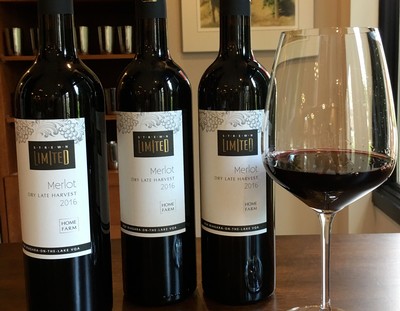
As the saying goes: the best time to drink a wine is when the bottle is open! All kidding aside, at least 99% of wines are ready to drink by the time they are available for sale. However some wines do benefit from cellaring and will be more enjoyable to drink when they are mature in five, eight, 10 years or more. Aging allows flavours to mellow and the wine becomes more harmonious, balanced and complex.
It is difficult, if not impossible, to pinpoint exactly when a wine will be at its peak. Here are a few factors to keep in mind when you are trying to decide whether to drink now or save for later.
1. Tannins
Red grapes traditionally associated with the Bordeaux region such as Cabernet Sauvignon, Cabernet Franc and even Merlot are often made with concentration of flavour, more structure and higher levels of tannins. When they are young, these wines can be described as tight, closed, astringent or harsh.
Over time as tannins combine and soften, the wines will develop a pleasant silken texture. We fondly remember the Terroir Cabernet Franc from the 1998 vintage which was so tannic and assertive when it was bottled that it was nicknamed the Cellar Monster (but drinking well 15 years later).
2. Acidity
Acidity keeps a wine tasting fresh but becomes gentler over time. White wines with high acidity have greater potential to age gracefully because the acidity helps protect against oxidation.
Of all the white varieties, Riesling continues to evolve and mature over time in the bottle with its fresh, fruity flavours replaced with more minerality and classic bottle-aged characteristics. Strewn’s soon to-be-sold out Riesling from 2014 is a gorgeous example of this.
As the fruit drops away in a lower-acid Chardonnay, it will show more toasty oak and earthy notes which some love and others don’t.
Icewines made from Vidal or Riesling grapes are noted for their sweetness (residual sugar) which when balanced by acidity allows them to evolve from fresh fruit flavours to dried fruits, caramel and butterscotch.
3. Vintage
Mother Nature definitely has a say in whether a wine will be suitable for cellaring. Niagara is considered a cool climate wine region and not every year has enough hot, dry, sunny days to produce grapes with concentrated flavours and higher levels of tannins. On average, Strewn makes its top-tier Terroir reds every second year. The last vintage was 2016 and these wines are benefiting from still more mellowing time before being released. It pays to know weather patterns by year!
4. Viticultural Practices and Wine-Making Style
What happens in the vineyard can play a significant role in producing grapes with bigger flavour and tannins. These include shoot thinning, leaf removal and canopy management to open grapes to the sun, and crop thinning to ensure maximum flavour and ripeness.
Wine-making style is also something that impacts whether a wine is a suitable candidate for cellaring. With the demand for ready-to-drink wines, particularly reds, winemakers can craft wines that are more fruit-forward, softer and lower in tannins. They may be delicious to drink while young but won’t improve with cellaring.
5. Proper Storage
Wines keep best in consistent temperature rather than ones that fluctuate. Ideally, temperatures should be around 13°C / 55°F. The warmer the temperature and the more temperature variations your wine undergoes, the sooner it will mature.
6. Personal Preference
Tastes differ and yours is the one that counts! Do you prefer wines with a fresh, fruity quality or those with heavy tannins? Vibrant and fruity or soft and mellow? Rich and velvety? Know the wine styles you enjoy and don’t be swayed by someone else’s. Of course, you can always put aside a bottle that will benefit from aging to celebrate a special occasion in the future.
How to Track Wine Aging in the Cellar
- Taste! Open a bottle periodically (perhaps once a year); part of the pleasure is seeing how it is developing
- Keep a wine journal or diary and record the date you taste a bottle along with your comments. Once you don’t notice changes from one bottle to the next, it probably won’t benefit from additional cellaring.
- Use cellar labels to help you remember a wine that may be near its prime (mark the date by which the bottle is to be opened).
Celebrating Success on the International Stage

For the last few years our focus has been on expanding our selection of premium and distinctive small lot wines, adding Sparkler, Muscat and Pinot Grigio to our white lineup, and creating a special set of fraternal twins Cabernet Sauvignon Sandy Block and Clay Block. Mother Nature was on our side and the 2015 and 2016 vintages yielded concentrated red grapes with excellent flavour and tannins, just what we need to make our Terroir Strewn Three, Cabernet Sauvignon, Cabernet Franc and Merlot.
In 2018, we decided it was time to see how well our wines would be received on the international stage and selected five top international competitions to enter. The result was overwhelmingly positive: six silver medals, five bronze medals, six commendations. In addition, our 2015 Terroir Merlot was selected as one of Canada's Top 100 Wines for the Six Nations Wine Challenge where it was a Judges Selection. Results Below.
Strewn makes three distinctively different Terroir Chardonnays, each fermented in a different type of barrel: French Oak, American Oak and Canadian Oak. Last year for the first time we participated in the Cool Climate Chardonnay Celebration. better know as i4C. It's not a competition but an amazing weekend of Chardonnay tasting activities. Our Terroir Chardonnay French Oak and Canadian Oak were tasted along side many excellent Canadian and international Chardonnays, and we partnered with Josef Chrony winery from Tasmania for a special side-by-side tasting. Look for us at the 2019 i4C weekend July 19 to 21. Check out the program at www.coolchardonnay.org.
MEDAL WINNERS IN 2018
2016 Terroir Chardonnay French Oak
- Silver Chardonnay de Monde
- Bronze International Wine & Spirits Competition
- Commended International Wine Challenge
2016 Terroir Chardonnay American Oak
- Commended Decanter World Wine Awards
2015 Cabernet Sauvignon Clay Block (Limited Supply)
- Silver International Wine & Spirits Competition
- Bronze International Wine Challenge
- Bronze Decanter World Wine Awards
2015 Cabernet Sauvignon Sandy Block (Limited Supply)
- Silver International Wine & Spirits Competition
- Commended International Wine Challenge
- Commended Decanter World Wine Awards
2017 Gewurztraminer Totally Botrytis Affected (Limited Supply)
- Silver International Wine & Spirits Competition
2016 Riesling Winemakers Art (Sold Out)
- Silver International Wine Challenge
- Commended Decanter World Wine Awards
2016 Riesling Terroir (Sold Out)
- Bronze International Wine & Spirits Competition
2014 Cabernet Franc Dry Late Harvest (Sold Out)
- Bronze International Wine & Spirits Competition
2015 Merlot Terroir (Library Wine)
- Commended International Wine Challenge
- Judges Award Six Nations Wine Challenge
2016 Chimo Vidal Icewine
- Silver International Wine & Spirits Competition
Inspired by our success, we have entered two additional international competitions in 2019. Fingers are crossed until we hear the results!
Wine Tips for a Get-Together
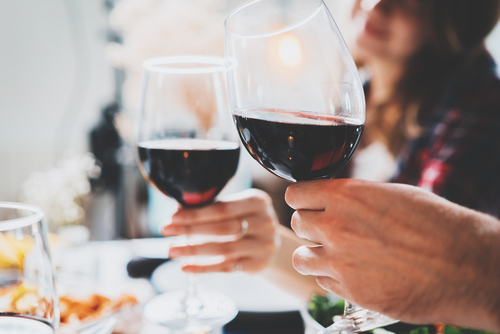
Holidays and entertaining go hand-in-hand and wine can play a starring role in a get-together. Here are some wine tips to consider when you are hosting a small or large gathering.
Pick Your Own “House Wine”
Unless you know guests are wine connoisseurs, a party is usually not the best time to pull out special bottles you have been saving. Instead look for wines that will be crowd-pleasers and choose a white and a red to offer as your house wine which will appeal to a wide range of tastes. These tend to be easy drinking/food friendly/lower in tannin, with 12% or less alcohol content. They are often less expensive and may have a little sweetness.
To determine the mix of red and white wine, go with an even split if you are not sure which your guests prefer. This is a change from the traditional two-thirds white and reflects changing wine tastes.
White wines vary from full-bodied buttery, toasty Chardonnays to crisp, refreshing whites with lots of fruit such as Rieslings and Sauvignon Blanc. Both these styles can pair well with holiday meals. Red wines can be medium or full-bodied but consider choosing reds with softer tannins (big tannin reds cry out for high protein meats such as lamb and steak rather than appetizers or snacks).
The “Wine Bar”
Be a responsible host and pour wine instead of setting out bottles and allowing guests to serve themselves. Plan to serve two drinks per person in the first hour of your event then one drink during each following hour.
Start by pouring less wine than the usual 5-ounces. Stay away from using oversized wine glasses or you may discover the wine doesn’t go nearly as far as you expected. For a larger group, you may want to rent glasses (no washing required afterwards!) rather than risk breakage of your own delicate or costly stemware.
If you are offering a selection of wines (e.g. more than one white and red or a sparkling or dessert wine), serve 2 or 3-ounce pours so guests can taste and compare wines throughout your get together.
To help guests pace themselves offer a selection of non-alcoholic beverages, such as sparkling or still water, juice, soft drinks, non-alcoholic punch or cider. And don’t automatically offer to refill an empty glass with wine.
Food slows down the speed at which the body absorbs alcohol. Offer veggies, cheeses and light dips during the gathering. Avoid salty, sweet or greasy foods, which tend to make people thirstier. Check out this easy recipe for Emerald Edamame Spread >> courtesy of the Wine Country Cooking School.
How Much Wine to Allow
Wine Math: a 750 mL bottle = 5 (5-ounce) glasses or 6 (4-ounce) glasses. We normally allow one-third of a bottle per person. A 750 mL bottle of sparkling wine (poured into flutes) = 8 servings.
Stand up parties – allow one 4-ounce glass of wine per guest per hour and expect one or two refills. Fill wine glasses no more half full to minimize the risk of wine being spilled while guests are talking and circulating. And have some Wine Away or other red wine stain remover on hand just in case you need it.
Sit down dinners – allow two 4-ounce glasses of wine per hour as people tend to drink more at dinner. Serve water with the meal and keep water glasses full.
Most people drink less at afternoon gatherings than they do in the evening (think about serving lighter-style and sparkling wines).
The right "coolness" for serving
Here is a general guidelineto help you serve wine at the best temperatures.
Whites and rosés: refrigerate for a few hours before serving
Reds: refrigerate for 15 minutes before serving
Sparkling: refrigerate then keep on ice between pours
Remember the cooler the wine, the more refreshing it will taste but the aromas will be subdued.
Last But Not Least – Be a Responsible Guest
In Canada the maximum blood alcohol content (BAC) for fully licensed drivers is 50 milligrams of alcohol in 100 millilitres of blood (0.05). More than that and you may have your license suspended. Driving with a BAC over 0.08 is a criminal offence.
The enzyme in the liver that eliminates alcohol works at different rates depending on genetic background, gender, weight, and food intake before drinking. As a rule of thumb to stay within the 0.05 blood alcohol concentration limit, consume no more than two 5-ounce glasses of wine if you're a man or one glass if you're a woman.
2017 Vintage Update
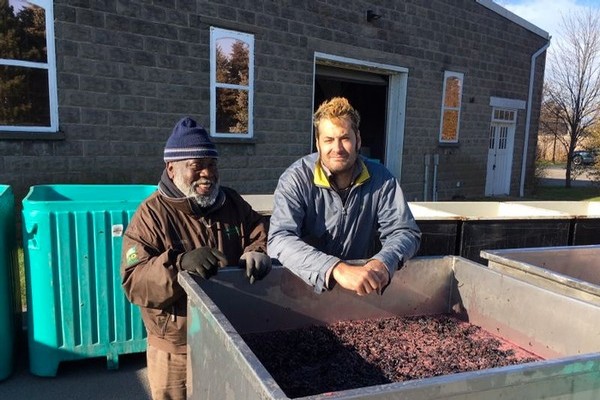
To say 2017 has been an up-and-down year might be a bit of an understatement. But if I had to sum it up, I would say it paid to be patient.
The cool, wet weather during the early part of the year pushed everything back by about three weeks. On November 10, the temperature reached -6C – almost cold enough for Icewine – and we had just started to harvest the red grapes. That said, the six-week run from mid-August through the end of September really helped turn things around. The stars truly aligned during prime ripening time with two weeks of gorgeous weather late September, the only run of days over 30C this year.
Our focus has been on exceptional vineyard management, critically important to ensuring optimum fruit quality and maintaining the soundness of the fruit. We followed our normal practices of shoot-thinning, cane-tucking, canopy-hedging and grape thinning. But where we would normally do one walk through a vineyard to check progress, this year we did two.
Grapes were harvested according to the late season to achieve maximum fruit maturity. Grapes for white wines were harvested first and the sugars in some was higher than expected and the juice is very aromatic. There is also lively acidity where we like it, especially in Riesling and Sauvignon Blanc (2017 SB will have more typical herbal varietal notes). Chardonnays should be real full-bodied and textured. Gewurztraminer has very good typicity with floral and spicy bursting out.
The red grapes - Merlot, Cabernet Franc and Cabernet Sauvignon - tfrom our Home Farm Vineyard and two other small vineyards were all harvested between November 20 and 24, a new record for last pick. This late in the season there is some dehydration on the fruit and sugars are over 25 brix. The result is really ripe, rich, absolutely fantastic flavours. Well worth the wait!
Marc P. Bradshaw
Winemaker
